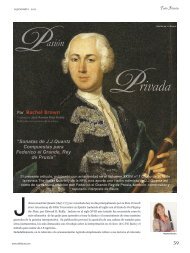Telemann Fantasias article + music - Rachel Brown
Telemann Fantasias article + music - Rachel Brown
Telemann Fantasias article + music - Rachel Brown
Create successful ePaper yourself
Turn your PDF publications into a flip-book with our unique Google optimized e-Paper software.
major Sonata BWV1035 (ex.7) and by Mozart’s time, ornamentation was just as<br />
common in an allegro (ex.8).<br />
Allegro<br />
!<br />
# "<br />
$ $ $ $<br />
# $ $ $ $<br />
%<br />
&<br />
% ' % ' % % % % % % % % % % % %<br />
% *<br />
% % % % % % % % % % % % % % % % % %<br />
Ex.7 J.S Bach Sonata in E major BWV 1035, Allegro, bars 1-8<br />
" !<br />
#<br />
Allegro maestoso<br />
$ $! $ $ $<br />
" # $<br />
$ $ %<br />
$! $ $ $ $ $ $ $ $ 3 # $ &%<br />
3<br />
(<br />
% ' % ' % % ) % &<br />
(<br />
% ' % ' % % ) )<br />
Ex.8 Mozart Concerto in G major, K313, Allegro maestoso, bars 149-150 and<br />
153-154<br />
So perhaps the many dance movements with binary repeats in the fantasias are ripe<br />
for decoration. Both Quantz and <strong>Telemann</strong> left examples which were heavily<br />
ornamented from start to finish, yet Quantz added that “You must never do so in<br />
excess, lest the principal notes be obscured, and the plain air be unrecognizable. You<br />
must play the principal subject at the very beginning just as it is written. If it returns<br />
frequently, a few notes may be added the first time, and still more the second, forming<br />
either running passage-work, or passage-work broken through the harmony. The third<br />
time you must again desist and add almost nothing, in order to maintain the constant<br />
attention of the listeners”. 1 Such ornamentation was meant to be improvised, or at<br />
least sound as if it were freshly dreamt up.<br />
The subject of articulation in these flute fantasias is fascinating. Slurs are sparse,<br />
surprisingly so. Some movements contain no slurs at all. This may be partially<br />
because of <strong>Telemann</strong>’s relative inexperience with engraving; his Methodical Sonatas<br />
and subsequent publications contain many more. However, it is also true that Baroque<br />
composers generally notated fewer slurs than some modern editors would have us<br />
believe and that players made use of a wide variety of contrasting tonguing syllables<br />
instead.<br />
Conventionally, various grades of ti and di would be used to differentiate between<br />
detached repeated notes or leaps and smooth melodic lines. Pairs of notes could be<br />
tongued with di-ri and extended to di-ri-di-ri or di-Ri-di-Ri depending on how the<br />
1 Quantz, Versuch, tr. E. Reilly, On Playing the Flute, chapter 14§14




